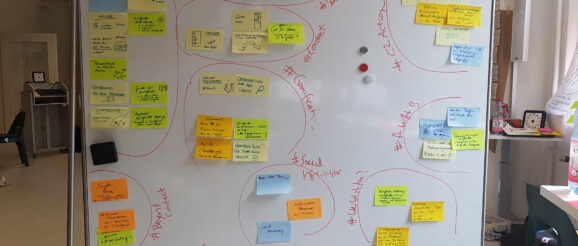Creating a lab culture that encourages innovation – Carter Lab

Postdoc Simon Ripperger gave a presentation at our virtual lab meeting this week on “design thinking and social innovation”. Innovation is a critical driver for the success of most organizations. Many large companies spend significant time and money trying to understand how to develop cultures and incentive structures that foster innovation. Companies like Google do extensive research on the topic of social innovation and have created courses for teaching it. Design thinking has slowly permeated the business world.
Innovation is obviously a huge part of science too. The foundation and framework of science is the development of innovative new theory, and empirical work moves forward with creative methodological solutions. Just consider the many scientific breakthroughs arising from innovations in technology. In our own field, we have the revolutionary impacts of next-generation sequencing in molecular ecology, ultrasonic microphones in bioacoustics, GPS tags in movement ecology, developments in miniaturization from mobile phones applied to biologging, and so on. It’s a reciprocal process: research labs are enabled by the latest technology and many widespread transformative technologies started in research labs. In fact, the “world wide web” was invented so that scientists could share information and data.
In many ways, scientists are also designers. We design research programs and proposals, experiments, papers, and presentations. Some of us design software, courses, and tools. Yet strangely enough, scientists don’t often think carefully about whether our own labs foster a culture that actively promotes big new ideas and creativity. Even worse, many aspects of scientific and academic culture actually seem to stifle creativity. We like to build gradually and incrementally on what we’ve done before. We and our funders are often risk averse. Most research projects need to yield short-term incremental results within a period of 1 to 3 years. Students often feel afraid to share their ideas, to think-outside-the-box, or to try something new. Early science courses often force students to memorize facts before it engages their creativity.
There are clear benefits to this steady and incremental approach in science, but many of the biggest breakthroughs undoubtedly come from thinking creatively and big. Humans are social creatures and creativity comes not from lone geniuses, but from social environments. So facilitating this kind of innovative thinking requires a social environment where people are free to experiment and to fail quickly without shame, to share and discuss ideas even if they might seem weird or crazy. Simon pointed to research showing that companies allocating as little as 10% of their resources to innovation reaped substantial benefits from innovation in the long run. Perhaps this idea could be adopted by academic labs: we could set aside time to ‘think big’ during lab meetings.
Another topic we discussed was the need to discuss failures in research rather than only successes. We tend to see the finish project, but not the days/months/years of setbacks and failed attempts, and this creates a false picture of how research actually works. Often the best path is not one that ‘avoids failure’, but one that enables us to ‘fail quickly and often’.
Here are some useful links Simon shared on how to boost creativity and foster innovation, how to break routines, and how to think outside the box. A great starting point are the two podcasts below on how leaders in innovation create an environment that empowers team members.
Two podcasts
Fueling an innovation engine with Google’s “Chief Innovation Evangelist”, Frederik G. Pferdt
Psychological safety as a driver of innovation with Frederik G. Pferdt, and IDEO Ceo Tim Brown: How Google and IDEO foster Creativity
Three articles
A practical guide with tools:
g.co/rework/innovation – Learn to build the skills for innovation and make it a part of your workplace.
Undergraduate student Emma Kline is taking classes in design thinking at OSU and told us about a design researcher at OSU, Liz Sanders.
It’s fun to think about what specific concrete behaviors in our own lab might result from applying these ‘design thinking’ principles. Here are some questions that come to my mind:
